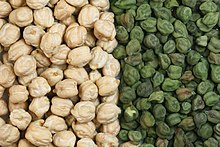Chick peas
| Chickpea | |
|---|---|
 |
|
| White and green chickpeas | |
 |
|
| Sprouted chickpea | |
| Scientific classification | |
| Kingdom: | Plantae |
| (unranked): | Angiosperms |
| (unranked): | Eudicots |
| (unranked): | Rosids |
| Order: | Fabales |
| Family: | Fabaceae |
| Genus: | Cicer |
| Species: | C. arietinum |
| Binomial name | |
|
Cicer arietinum L. |
|
| Synonyms | |
|
|
| Nutritional value per 100 g (3.5 oz) | |
|---|---|
| Energy | 686 kJ (164 kcal) |
|
27.42 g
|
|
| Sugars | 4.8 g |
| Dietary fibre | 7.6 g |
|
2.59 g
|
|
| Saturated | 0.269 g |
| Monounsaturated | 0.583 g |
| Polyunsaturated | 1.156 g |
|
8.86 g
|
|
| Vitamins | |
| Vitamin A equiv. |
(0%)
1 μg |
| Thiamine (B1) |
(10%)
0.116 mg |
| Riboflavin (B2) |
(5%)
0.063 mg |
| Niacin (B3) |
(4%)
0.526 mg |
| Pantothenic acid (B5) |
(6%)
0.286 mg |
| Vitamin B6 |
(11%)
0.139 mg |
| Folate (B9) |
(43%)
172 μg |
| Vitamin B12 |
(0%)
0 μg |
| Vitamin C |
(2%)
1.3 mg |
| Vitamin E |
(2%)
0.35 mg |
| Vitamin K |
(4%)
4 μg |
| Minerals | |
| Calcium |
(5%)
49 mg |
| Iron |
(22%)
2.89 mg |
| Magnesium |
(14%)
48 mg |
| Phosphorus |
(24%)
168 mg |
| Potassium |
(6%)
291 mg |
| Sodium |
(0%)
7 mg |
| Zinc |
(16%)
1.53 mg |
| Other constituents | |
| Water | 60.21 g |
|
|
| Percentages are roughly approximated using US recommendations for adults. Source: USDA Nutrient Database |
|
The chickpea or chick pea (Cicer arietinum) is a legume of the family Fabaceae, subfamily Faboideae. Its different types are variously known as gram, or Bengal gram,garbanzo or garbanzo bean, Egyptian pea,ceci, cece, chana, or Kabuli chana. Its seeds are high in protein. It is one of the earliest cultivated legumes: 7,500-year-old remains have been found in the Middle East.
The name "chickpea" traces back through the French chiche to cicer, Latin for 'chickpea' (from which the Roman cognomen Cicero was taken). The Oxford English Dictionary lists a 1548 citation that reads, "Cicer may be named in English Cich, or ciche pease, after the Frenche tongue." The dictionary cites "Chick-pea" in the mid-18th century; the original word in English taken directly from French was chich, found in print in English in 1388.
The word garbanzo, from an alteration of Old Spanish arvanço, came first to American English as garvance in the 17th century, being gradually anglicized to calavance, though it came to refer to a variety of other beans (cf. calavance). The current form garbanzo comes directly from modern Spanish, and is commonly used in regions of the United States with a strong Mexican or Spanish influence.
Domesticated chickpeas have been found in the aceramic levels of Jericho (PPNB) along with Çayönü in Turkey and in Neolithic pottery at Hacilar, Turkey. They were found in the late Neolithic (about 3500 BCE) at Thessaly, Kastanas, Lerna and Dimini, Greece. In southern France, Mesolithic layers in a cave at L'Abeurador, Aude, have yielded wild chickpeas carbon dated to 6790±90 BCE.
...
Wikipedia
